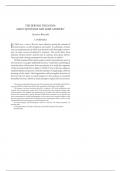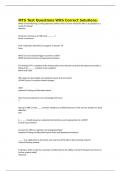THE DERVENI THEOGONY:
MANY QUESTIONS AND SOME ANSWERS*
ALBERTO BERNABÉ
I. PURPOSES
I N 1962 NEAR A TOMB IN DERVENI, near Salonica, among the remains of
a funeral pyre, a scroll of papyrus was found.1 It contained a curious
text, an important part of which was devoted to the thorough commen-
tary of some verses attributed to Orpheus. The scroll dates from
between 340 and 320 BC2 and the text it contains, from about 400 BC.
The poem that is being commented on must be prior to 500 BC.3
All that remains of the Orphic poem is a series of quotations, more or
less extensive. In a paper published in Kernos,4 I undertook a philological
reconstruction of the poem. Now my purpose is to study the segments
of the reconstructed text in depth. I will do it from a literary, religious,
and philosophic perspective, with the intention of regaining a coherent
meaning of the whole. The fragmentary and incomplete character of
the text will not allow as much progress in the analysis as would be
desirable; however, I think we must attempt to explain the text we have.
* This paper has benefited from the aid of the Spanish State (HUM2006-09403/FILO). I
am very grateful to Helena Bernabé for the translation of this paper into English.
1 The papyrus has been recently edited by Casadesús 1995 (with translation into
Catalan and commentary), Janko 2003 (with translation into English), Betegh 2004
(with translation into English and commentary), by Jourdan 2003 (with translation into
French and commentary), and by Bernabé 2004b (with translation into Spanish and
short commentaries). Ample bibliographies can be found in the complete edition of the
Derveni papyrus by Kouremenos, Parássoglou, and Tsantsanoglou 2006, as well as in the
fundamental work on the papyrus by Laks and Most 1997.
2 So Tsantsanoglou and Parássoglou 1988:125, 1992:221. For other proposals, cf.
Bernabé 2002.
3 Cf. Bernabé 2002 on the date of the text and possible identity of the author.
4 Bernabé 2002.
,100 Alberto Bernabé
I will examine the literally quoted fragments, as well as the parts of
the commentary that tell us something about the content of the text
the commentator read but did not quote. The text and the numbering
correspond to the ones of the edition of this theogony in the Bibliotheca
Teubneriana.5 There and in the quoted Kernos article can be found the
philological basis for the reconstruction of the text. The translation of
the verses is Janko’s (except where noted).
II. ANALYSIS OF THE TEXT
Our analysis follows the order of the fragments and deals with the
diverse problems of interpretation found in the text.
II.1. The Proem
The proem begins with a verse we know from other Orphic works and
which seems to be a kind of σφραγίς of Orpheus (OF 3):6
φθέγξομαι οἷς θέμις ἐστί· θύρας δ᾿ ἐπίθεσθε βέβηλοι.
I will speak for those entitled, close your doors, ye profane.7
Unlike proems such as those by Homer or Hesiod, where the poem is
recited for any kind of public, this is directed at a few listeners, defined
as those to whom it is licit to speak. The entitlement (θέμις) required to
hear the poem specifically excludes the βέβηλοι “profane,” who must
(metaphorically) close their doors. βέβηλοι is usually opposed to “initi-
ates,” thus it seems clear that the condition for reading the poem is to
be initiated. This implies:
a) That the hearer must have a previous knowledge about what is
being talked about. This supposition is expressed in a clearer way in an
alternative formula we find in the first verse of other Orphic poems:
ἀείσω ξυνετοῖσιν· θύρας δ᾿ ἐπίθεσθε βέβηλοι “I will sing for those of
understanding.”8 Consistent with this feature is the fact that some
5 I will quote this edition as OF.
6 Bernabé 1996.
7 Translation by West 1983:83.
8 Translation by West 1983:83.
, The Derveni Theogony 101
substantial details of the story are only summarily mentioned9 and they
require turning to other texts in order to be correctly interpreted.
b) That the hearer is in a certain state of religious character, which
may involve moral or premoral conditions, perhaps having to do with
Justice (compare the ancient references to Dike in Orphic texts 10),
or with purity (according to the declaration of the mystai in front of
Persephone in the leaves of Thurii).11
All this necessarily means that the poem is not sensu stricto an initia-
tion poem, it does not offer the first information received by the person
that is going to be integrated into the group of initiates, but it adds to
the information previously received.
So far, everything seems clear; there are, however, two questions we
cannot answer:
1) The first is the fact that the formula can be interpreted in two
different ways: (a) the poem was only recited in front of initiates, in
such a way that even access to the place where the text was recited and
to the text itself was forbidden to the βέβηλοι, or (b) although the text
could circulate without restrictions, it was directed only at the initiates,
since only they were able to understand it. The later use of the formula
by authors of technical works, which were distributed openly, but
which could not be understood by everybody, makes the second inter-
pretation more plausible.12 The task of making the text understandable
would fall to the sort of people mentioned by Plato:13
. . . ἀνδρῶν τε καὶ γυναικῶν σοφῶν περὶ τὰ θεῖα πράγματα
. . . τῶν ἱερέων τε καὶ τῶν ἱερειῶν ὅσοις μεμέληκε περὶ ὧν
μεταχειρίζονται λόγον οἵοις τ᾿ εἶναι διδόναι .
. . . from wise men and women who told of things divine . . .
9 I will later define this characteristic as “narrative speed.”
10 Pl. Lg. 716a (OF 32), Ps.-D. 25.11 (OF 33).
11 OF 488–490. In a fragment of the Rhapsodies (OF 340) οἳ μέν κ᾿ εὐαγέωσιν are opposed
to οἳ δ᾿ ἄδικα ῥέξαντες. This implies that following Justice is a feature of the ritual purity
among the Orphics, or, in other words, that acting against Justice means committing an
impure act.
12 Cf. Bernabé 1996.
13 Pl. Men. 81a, cf. Bernabé 1999. The relationship of the commentator with the people
alluded to by Plato is pointed out by West 1997:84.
, 102 Alberto Bernabé
they are certain priests and priestesses who have studied so
as to be able to give a reasoned account of their ministry.
Translation by W. R. M. Lamb
The Derveni commentator belongs to this group of people and,
distantly, Plato himself, who often offers sui generis interpretations of
Orphic texts.14
2) The second question would be which specific ritual our text is
related to, whether it is really the ἱερὸς λόγος of a ritual.15 Among other
possibilities, we could consider the θυηπολία alluded to in the Platonic
clause (Pl. R. 364e) οἷς θυηπολοῦσιν or any of the rituals commented on
in the first section of the papyrus.
II.2. The Plan of the Work
The poet states what he is going to deal with in the poem (OF 4):
ο]ἳ Διὸς ἐξεγ̣έ̣νοντο [ὑπερμεν]έος βασιλῆ̣ος.
those who were born of Zeus the almighty king.
This sole verse is extremely significant, since we find several funda-
mental statements in it:
a) Zeus’ power is indisputable.
b) The topic of the poem is precisely the birth of these gods (οἵ,
nominative masculine plural, must refer to “gods”).
c) The gods were born of Zeus.
It is very illustrative to compare this verse with the one used by
Hesiod in similar circumstances, that is, in the exposition of the plan of
his Theogony (106):
οἳ Γῆς ἐξεγένοντο καὶ Οὐρανοῦ ἀστερόεντος
those that were born of Earth and starry Sky.
In both verses there is a relative pronoun as subject referring to
the gods. Both verses use the same verb ἐξεγένοντο; that is, we are told
14 Cf. Bernabé 1997.
15 On ἱεροὶ λόγοι, cf. Henrichs 2003.





